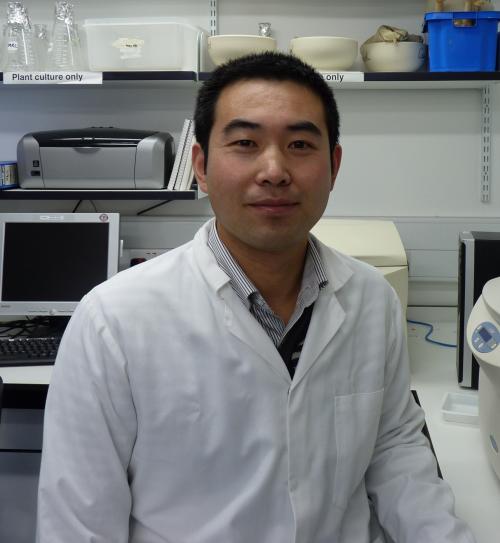
The MacKintosh and Sakamoto teams define a key step in insulin control of blood sugar
Glucose sugar surges into our bloodstream after a meal, and is directed to enter muscle and fat cells under control of the hormone insulin. Understanding how insulin controls glucose distribution is of enormous practical significance because an increasing worldwide epidemic of people are developing sluggish responses to insulin -- a condition called 'insulin resistance' that is a hallmark of type 2 diabetes.
A few years ago, Shuai Chen and Kathryn Geraghty in Carol MacKintosh's group as well as David James' group at the Garvan Institute in Sydney, found that insulin triggers a protein named AS160 (Akt substrate 160kDa) to be captured by C-shaped proteins named 14-3-3s inside muscle and fat cells [PMID: 17617058]. Suspecting AS160 to be involved in insulin control of glucose metabolism, Carol and Shuai teamed up with Kei Sakamoto, a Programme Leader in the Unit who has set up a state-of-the-art Molecular Physiology Laboratory. Together the team discovered that mice whose AS160 is genetically mutated so that it cannot bind to 14-3-3s are markedly impaired in clearing their blood glucose into muscle in response to insulin.
The AS160-mutant mice have abnormally high amounts of a specialised glucose transporter called GLUT4 that assists glucose delivery into muscle and fat cells. But, despite having more GLUT4, the mutants do not move the GLUT4 efficiently into the correct position to let glucose into the muscle. These findings establish that AS160 plays a key role in glucose control by correctly navigating GLUT4 in response to insulin. Recent genetic studies have also identified a few people with a rare form of diabetes who have faulty AS160, and it would be very informative to characterise GLUT4 function in these people.
Just as you need to understand how engines work before you can fix a car, understanding the internal machinery of glucose control in muscle should provide new ways to improve blood glucose management in people. One idea is that a drug could be developed to mimic the function of AS160 in controlling the movement of GLUT4 inside muscles, and thereby lower blood glucose levels.
Drugs are not the only answer however. Exercise has a powerful effect in regulating blood glucose, even in people with insulin resistance. How? Here too, the team have clues. TBC1D1, which is a sister protein to AS160, also binds to 14-3-3s – but this time during exercise, and also in response to drugs that mimic some effects of exercise [PMID: 17995453]. AS160 and TBC1D1 therefore seem to be the complementary Yin and Yang of glucose control – with insulin regulating glucose levels via AS160, and exercise regulating glucose via TBC1D1. Lots of experiments are under way to test these hypotheses!
The researchers thank the Medical Research Council, Diabetes UK and Dundee and District Diabetes UK Voluntary Group for their enthusiastic support and funding. Also, David Wasserman of Vanderbilt University who contributed critical experiments to the new study, which is published in the journal 'Cell Metabolism'. [PMID: 21195350] and highlighted in the Diabetes UK website.
A few years ago, Shuai Chen and Kathryn Geraghty in Carol MacKintosh's group as well as David James' group at the Garvan Institute in Sydney, found that insulin triggers a protein named AS160 (Akt substrate 160kDa) to be captured by C-shaped proteins named 14-3-3s inside muscle and fat cells [PMID: 17617058]. Suspecting AS160 to be involved in insulin control of glucose metabolism, Carol and Shuai teamed up with Kei Sakamoto, a Programme Leader in the Unit who has set up a state-of-the-art Molecular Physiology Laboratory. Together the team discovered that mice whose AS160 is genetically mutated so that it cannot bind to 14-3-3s are markedly impaired in clearing their blood glucose into muscle in response to insulin.
The AS160-mutant mice have abnormally high amounts of a specialised glucose transporter called GLUT4 that assists glucose delivery into muscle and fat cells. But, despite having more GLUT4, the mutants do not move the GLUT4 efficiently into the correct position to let glucose into the muscle. These findings establish that AS160 plays a key role in glucose control by correctly navigating GLUT4 in response to insulin. Recent genetic studies have also identified a few people with a rare form of diabetes who have faulty AS160, and it would be very informative to characterise GLUT4 function in these people.
Just as you need to understand how engines work before you can fix a car, understanding the internal machinery of glucose control in muscle should provide new ways to improve blood glucose management in people. One idea is that a drug could be developed to mimic the function of AS160 in controlling the movement of GLUT4 inside muscles, and thereby lower blood glucose levels.
Drugs are not the only answer however. Exercise has a powerful effect in regulating blood glucose, even in people with insulin resistance. How? Here too, the team have clues. TBC1D1, which is a sister protein to AS160, also binds to 14-3-3s – but this time during exercise, and also in response to drugs that mimic some effects of exercise [PMID: 17995453]. AS160 and TBC1D1 therefore seem to be the complementary Yin and Yang of glucose control – with insulin regulating glucose levels via AS160, and exercise regulating glucose via TBC1D1. Lots of experiments are under way to test these hypotheses!
The researchers thank the Medical Research Council, Diabetes UK and Dundee and District Diabetes UK Voluntary Group for their enthusiastic support and funding. Also, David Wasserman of Vanderbilt University who contributed critical experiments to the new study, which is published in the journal 'Cell Metabolism'. [PMID: 21195350] and highlighted in the Diabetes UK website.

